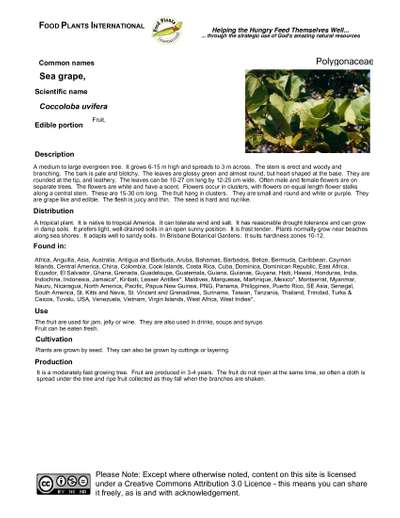
Edible portions : fruit
A medium to large evergreen tree. It grows 6-15 m high and spreads to 3 m across. The stem is erect and woody and branching. The bark is pale and blotchy. The leaves are glossy green and almost round, but heart shaped at the base. They are rounded at the tip, and leathery. The leaves can be 10-27 cm long by 12-25 cm wide. Often male and female flowers are on separate trees. The flowers are white and have a scent. Flowers occur in clusters, with flowers on equal length flower stalks along a central stem. These are 15-30 cm long. The fruit hang in clusters. They are small and round and white or purple. They are grape like and edible. The flesh is juicy and thin. The seed is hard and nut-like.
Distribution : A tropical plant. It is native to tropical America. It can tolerate wind and salt. It has reasonable drought tolerance and can grow in damp soils. It prefers light, well-drained soils in an open sunny position. It is frost tender. Plants normally grow near beaches along sea shores. It adapts well to sandy soils. In Brisbane Botanical Gardens. It suits hardiness zones 10-12.
Common names : Sea grape, Carnero, Jamaican kino, Khrut thale, Kino, Matora, Meybiskadhuru gas, Nho bien, Papaturro, Platter leaf, Pohon anggur laut, Schusterdruif, Shore grape, Sistri-droifi, Uva caleta, Uva de playa, Uva de praia, Uvero,
Synonyms : Polygonum uvifera L.;